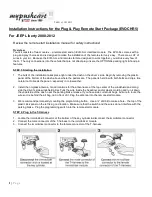
19
Riding On Hills
Chapter 10
When riding just about anywhere, you will encounter some type of hills.
An ATV can overturn more easily on extremely steep hills than on level
surfaces or small hills. Being prepared and knowing what to do will help
you on your journey. Always be sure to check your parking brake before
riding in hilly areas.
Going Up A Hill
Remember:
•
Some hills are too steep for your abilities. Use your common sense. If
the hill looks too steep, it probably is.
•
Some hills are just too steep for your ATV regardless of your abilities.
•
Never ride past the limit of your visibility - if you cannot see what is on
or over the crest of a hill, slow down until you have a clear view.
•
The key to being a good hill rider is to keep your weight uphill at all
times.
Climbing hills improperly could cause loss of control or cause the ATV
to overturn. Always follow the proper procedures for your ATV contained
in the owner’s manual. When approaching an uphill climb you should:
•
Keep your feet firmly on the footrests.
•
Shift the ATV into a lower gear and speed up BEFORE climbing the hill
so you can maintain momentum.
•
When approaching the uphill climb, move way up on the seat and lean
forward, or stand and position you torso over the front wheels.
•
As you are climbing, you may need to shift to a lower gear to prevent
lugging the engine or stalling. To shift into a lower gear on a hill
remember:
- Keep your body weight forward as you prepare to shift gears. For
steeper hills, lean forward as much as possible.
- Shift quickly while momentarily releasing the throttle: this will help
keep the front wheels from lifting.
If you do not have enough power to reach the top of the hill, but still
have forward momentum and enough room to turn around safely:
•
Keep your weight uphill.
•
Make a U-turn before you lose speed.
•
Proceed downhill in a lower gear, keeping your weight to the uphill
side.
If you are riding uphill and lose all forward momentum:
•
Keep your weight up hill, and apply the brakes and come to a stop.
Never allow the ATV to roll backward.
•
Apply the parking brake while keeping your weight uphill.
•
Dismount on the uphill side or to a side if pointed straight uphill, and
follow the procedure described in your owner’s manual.
Do not attempt to ride backward down a hill. Should you begin rolling
backward, do not apply the rear brake abruptly. Using the rear brake only
or abruptly could cause the ATV to roll over backward. If you begin rolling
backward:
•
Keep your weight uphill, and apply the front brake. If your ATV does
not have a front brake, follow the procedure described in your owner’s
manual.
•
When you are fully stopped. Apply the rear brake as well. Apply the
parking brake, dismount on the uphill side or to a side if pointed
straight uphill, and follow the procedure described in your owner’s
manual.
•
If the ATV continues to roll backward, dismount to the uphill side
immediately.
Getting to the Bottom
Always check the terrain carefully before you start down any hill.
Choose a path which is as straight downhill as possible with a minimum
of obstacles. Shift your weight to the rear and use a low gear. Follow the
procedures described in you owner’s manual for special braking tech-
niques for descending.
When going downhill:
•
Shift your weight to the rear (uphill).
•
Keep speed low.
•
Use gradual braking.
•
Use a lower gear.
•
Look ahead.
Traversing
When you go across a slope rather than directly up or down, it is called
traversing. Sometimes when a hill is steep it is necessary to climb it or
descend it by traversing.
Traversing a slope is tricky. Avoid traversing slopes with excessively
slippery, rough or loose surfaces.







































